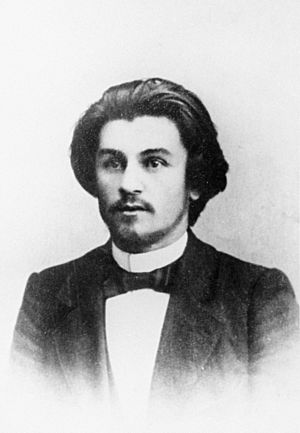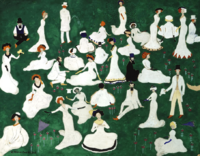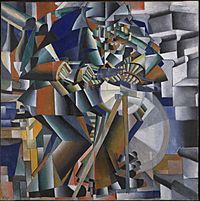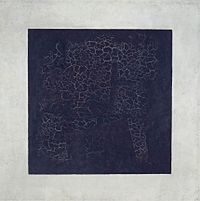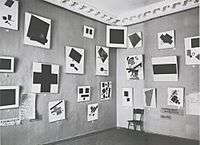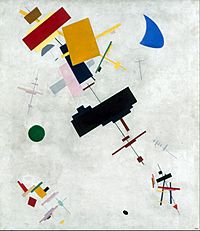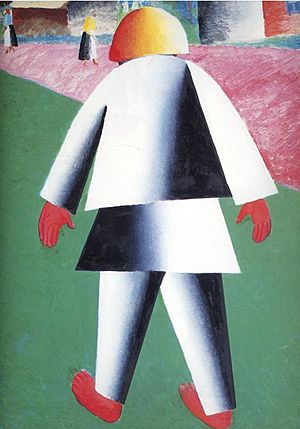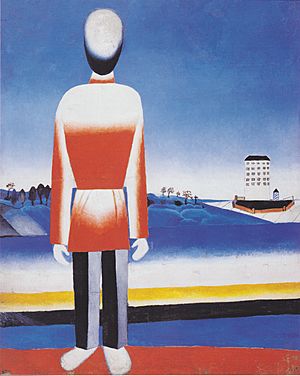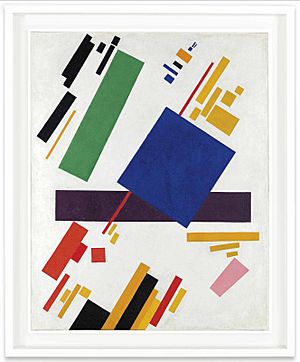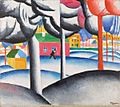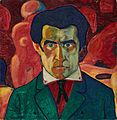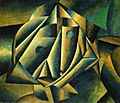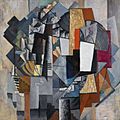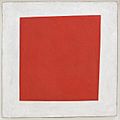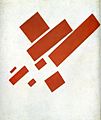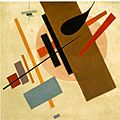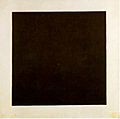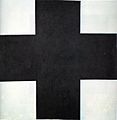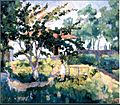Kazimir Malevich facts for kids
Quick facts for kids
Kazimir Malevich
|
|
|---|---|
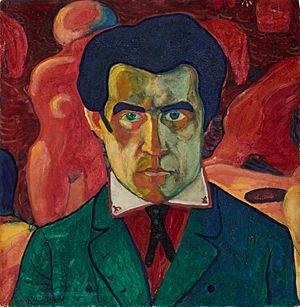
Self Portrait 1910
|
|
| Born |
Kazimir Severinovich Malevich
23 February 1879 |
| Died | 15 May 1935 (aged 56) |
| Nationality | Russian Empire → Soviet Union |
| Education | Moscow School of Painting, Sculpture and Architecture |
|
Notable work
|
An Englishman in Moscow, 1914; Black Square, 1915; White on White, 1918 |
| Movement | Suprematism |
Kazimir Severinovich Malevich (born February 23, 1879 – died May 15, 1935) was a famous Russian avant-garde artist and art thinker. His groundbreaking art and writings greatly influenced the development of abstract art in the 20th century.
Malevich was born in Kiev to a Polish family. He created a style called Suprematism. This art style aimed to move away from showing real-world objects. Instead, it focused on "pure feeling" and spirituality using simple shapes. Malevich is also seen as part of the Ukrainian avant-garde. This group included Ukrainian-born artists who worked in Ukraine and later in Europe and America.
In his early career, Malevich explored many art styles. He quickly learned from Impressionism, Symbolism, Fauvism, and Cubism. After visiting Paris in 1912, his art became simpler. He started using pure geometric shapes against plain backgrounds. His painting Black Square (1915) was a black square on a white background. It was one of the most abstract paintings ever made at that time. It marked a clear line between old art and new art. Suprematist Composition: White on White (1918) took his idea of pure abstraction even further. Besides painting, Malevich wrote down his ideas in books like "From Cubism and Futurism to Suprematism" (1915).
Malevich's life reflected the big changes happening around the October Revolution in 1917. After the revolution, new art movements like Suprematism were supported by some government groups. Malevich held important teaching jobs and had his own art show in Moscow in 1919. His fame grew in the West with shows in Warsaw and Berlin in 1927. From 1928 to 1930, he taught at the Kiev Art Institute. He also published articles in a magazine called Nova Generatsiia. However, new government rules in Ukraine made him return to Saint Petersburg.
By the early 1930s, modern art was not popular with the new government led by Joseph Stalin. Malevich soon lost his teaching job. His artworks and writings were taken away, and he was stopped from making art. In 1930, he was put in prison for two months because of his trips to Poland and Germany. He was forced to stop painting abstract art. In his last years, he painted in a more realistic style. He died from cancer in 1935 at age 56.
Despite these challenges, his art and writings influenced many artists. These included El Lissitzky and Alexander Rodchenko. He also inspired later abstract artists like Ad Reinhardt. After his death, his work was celebrated in major exhibitions. These were held at the Museum of Modern Art (1936) and the Guggenheim Museum (1973). The Stedelijk Museum in Amsterdam has a large collection of his work.
Contents
- Early Life and Art Beginnings
- Developing His Artistic Style
- The Rise of Suprematism
- Life After the Revolution
- International Recognition and Challenges
- His Final Years
- Painting Technique
- Malevich's Polish Roots
- Exhibitions After His Death
- Where to See His Art
- Art Sales and Records
- Selected Works
- Images for kids
- See also
Early Life and Art Beginnings
Kazimir Malevich was born Kazimierz Malewicz to a Polish family. They lived near Kiev in the Russian Empire. His parents, Ludwika and Seweryn Malewicz, were Roman Catholic. They had moved to Kiev after a failed Polish uprising in 1863.
Polish was his first language, but he also spoke Russian and Ukrainian. Malevich later wrote art articles in Ukrainian. He also identified himself as Ukrainian.
Kazimir's father managed a sugar factory. Kazimir was the oldest of fourteen children, but only nine lived to be adults. His family moved often. He spent most of his childhood in villages in modern-day Ukraine. These villages were surrounded by sugar-beet farms, far from big cities. Until he was twelve, he didn't know about professional artists. But art was all around him. He loved peasant embroidery and decorated walls. He could paint in the peasant style. He studied drawing in Kiev from 1895 to 1896.
Developing His Artistic Style
From 1896 to 1904, Kazimir Malevich lived in Kursk. In 1904, after his father died, he moved to Moscow. He studied at the Moscow School of Painting, Sculpture and Architecture from 1904 to 1910. He also studied in the studio of Fedor Rerberg in Moscow.
In 1911, he showed his work in an exhibition in St. Petersburg. This was with a group called Soyuz Molodyozhi (Union of Youth). In 1912, he took part in another exhibition with the group Donkey's Tail in Moscow. By this time, his art was influenced by Russian avant-garde painters like Natalia Goncharova. They were interested in Russian folk art called lubok.
Malevich described his painting style as "Cubo-Futurist" in 1912. In March 1913, a big exhibition of Aristarkh Lentulov's paintings opened in Moscow. This show had a huge impact. All the main Russian avant-garde artists, including Malevich, quickly started using Cubist ideas. In the same year, Malevich designed the stage sets for the Cubo-Futurist opera, Victory Over the Sun.
In 1914, Malevich showed his art in Paris. He also helped illustrate books of poems. Later that year, he made lithographs to support Russia joining World War I. These prints used strong blocks of pure colors. This style hinted at his later Suprematist work.
The Rise of Suprematism
In 1915, Malevich created Suprematism. He published his ideas in a book called From Cubism to Suprematism. From 1915 to 1916, he worked with other Suprematist artists. They worked in a peasant art group in villages like Skoptsi. From 1916 to 1917, he showed his art with the Jack of Diamonds group in Moscow. Famous Suprematist works include Black Square (1915) and White On White (1918).
Malevich first showed his Black Square in 1915. A black square against the sun first appeared in his designs for the opera Victory over the Sun in 1913. He painted other versions of Black Square later. His student Anna Leporskaya said that Malevich was so amazed by the Black Square that he couldn't eat or sleep for a week.
In 1918, Malevich designed the sets for a play called Mystery-Bouffe. He was also interested in aerial photography and aviation. This led him to create abstract art inspired by views from above. Some Ukrainian writers believe Malevich's Suprematism has roots in traditional Ukrainian culture.
Life After the Revolution
After the October Revolution in 1917, Malevich became involved in art organizations. He taught at the Vitebsk Practical Art School in Belarus (1919–1922). He also taught at the Leningrad Academy of Arts (1922–1927) and the Kiev Art Institute (1928–1930). He wrote a book called The World as Non-Objectivity. It was published in 1926 and explained his Suprematist ideas.
In 1923, Malevich became the director of the Petrograd State Institute of Artistic Culture. This school was closed in 1926. A newspaper called it "a government-supported monastery" that promoted "counterrevolutionary preaching." The Soviet government was pushing for a style called Socialist Realism. This style showed idealized, propaganda-like art. Malevich's art was the opposite of this.
International Recognition and Challenges
In 1927, Malevich traveled to Warsaw. He was welcomed like a hero. He met artists whose work was influenced by him. He held his first foreign exhibition there. From Warsaw, he went to Berlin and Munich for a big show of his art. This brought him international fame. He left most of his paintings behind when he returned to the Soviet Union.
Malevich thought that the Soviet government's view on modern art might change. But under Joseph Stalin, the government turned against abstract art. They saw it as "bourgeois" art that didn't show social realities. As a result, many of his works were taken away. He was also stopped from creating and showing similar art.
In 1930, he was arrested and questioned by the KGB in Leningrad. He was accused of being a Polish spy. He was released from prison in December. Critics said Malevich's art was bad because it didn't show love of life or nature. Malevich replied that art can grow for its own sake. He said, "art does not need us, and it never did."
His Final Years
Malevich died of cancer at age fifty-seven in Leningrad on May 15, 1935. His friends and students buried his ashes in a grave marked with a black square. He had wanted his grave to have a "architekton." This was one of his abstract skyscraper models with a telescope to look at Jupiter.
At his funeral, his Black Square painting was placed above him. People at his funeral were allowed to wave a banner with a black square. Malevich wanted to be buried under an oak tree near Nemchinovka. This was a place he felt connected to. His ashes were sent there and buried in a field near his dacha (country house). A friend designed a white cube with a black square for his burial site. This memorial was destroyed during World War II.
In Nazi Germany, his works were banned as "Degenerate Art." In 2013, an apartment building was built where Malevich's tomb was. Another monument to Malevich, put up in 1988, is now inside a gated community.
Painting Technique
Art historian Milda Victurina studied Malevich's painting technique. She found that he often layered paints to create special colors. For example, for a red spot, he would use a black layer underneath a red layer. When light passed through these layers, the red looked darker. This layering technique helps experts spot fake Malevich paintings.
Malevich's Polish Roots
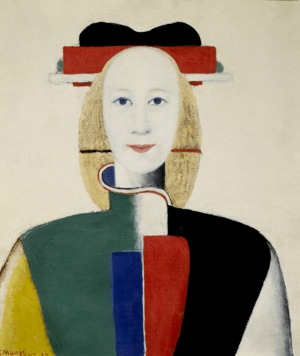
Malevich's family was part of the millions of Poles who lived in the Russian Empire. This was after the Partitions of Poland. Kazimir Malevich was born near Kiev. This land was once part of the Polish–Lithuanian Commonwealth. His parents were ethnic Poles.
Malevich spoke Polish, Ukrainian, and Russian. He would sign his artwork with the Polish spelling of his name, Kazimierz Malewicz. When applying for a visa to France, he stated his nationality as Polish. Art historian Andrei Nakov has argued that the Polish spelling of Malevich's name should be used.
In 1985, Polish artist Zbigniew Warpechowski performed "Citizenship for a Pure Feeling of Kazimierz Malewicz." This honored the artist and criticized Polish authorities for not giving Malevich Polish citizenship. In 2013, Malevich's family in New York City started a group. It aims to share information about Kazimir's Polish background.
Russian art historian Irina Vakar found documents from Malevich's criminal case. In some of these, Malevich stated his nationality as Ukrainian.
Exhibitions After His Death
Alfred H. Barr Jr. included some of Malevich's paintings in a key exhibition in New York in 1936. In 1939, the Museum of Non-Objective Painting opened in New York. Its founder, Solomon R. Guggenheim, collected Russian avant-garde art. He was inspired by Malevich's art and spiritual search.
The first U.S. exhibition of Malevich's work in 1973 sparked a lot of interest. It increased his influence on artists in America and Europe. However, most of Malevich's work was hidden until the time of Glasnost (openness) in Russia. In 1989, the Stedelijk Museum in Amsterdam held the first large Malevich exhibition in the West. It included paintings they owned and works from a Russian art critic's collection.
Where to See His Art
Malevich's works are in several major art museums. These include the State Tretyakov Gallery in Moscow. In New York, you can find his art at the Museum of Modern Art and the Guggenheim Museum. The Stedelijk Museum in Amsterdam has 24 Malevich paintings. This is more than any other museum outside of Russia. Another large collection is at the State Museum of Contemporary Art in Thessaloniki.
Art Sales and Records
A fourth version of his famous Black Square, painted in the 1920s, was found in 1993. It was bought for US$250,000. In 2002, the painting was sold for about US$1 million. This purchase was funded by Vladimir Potanin. He donated money to the Russian Ministry of Culture, which then went to the State Hermitage Museum. This was the largest private donation to state art museums since the October Revolution.
In 2008, the Stedelijk Museum returned five works to Malevich's family. These paintings had been left in Berlin by Malevich. The museum had bought them in 1958. In return, the museum kept the other Malevich paintings without dispute.
On November 3, 2008, one of these returned works, Suprematist Composition from 1916, set a world record. It was the highest price for any Russian artwork and any work sold at auction that year. It sold at Sotheby's in New York City for over US$60 million.
In May 2018, the same painting Suprematist Composition (1916) sold for over US$85 million at Christie's New York. This was a new record for a Russian artwork at auction.
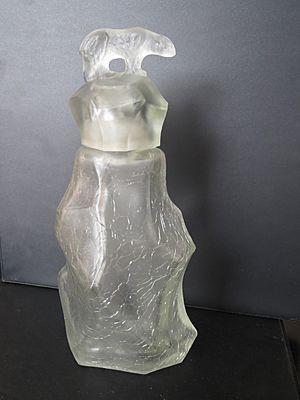
Selected Works
- 1912 – Morning in the Country after Snowstorm
- 1912 – The Woodcutter
- 1912–13 – Reaper on Red Background
- 1914 – The Aviator
- 1914 – An Englishman in Moscow
- 1914 – Soldier of the First Division
- 1915 – Black Square
- 1915 – Red Square †
- 1915 – Black Square and Red Square ††
- 1915 – Suprematist Composition
- 1915 – Suprematism (1915)
- 1915 – Suprematist Painting: Aeroplane Flying
- 1915 – Suprematism: Self-Portrait in Two Dimensions
- 1915–16 – Suprematist Painting (Ludwigshafen)
- 1916 – Suprematist Painting (1916)
- 1916 – Supremus No. 56
- 1916–17 – Suprematism (1916–17)
- 1917 – Suprematist Painting (1917)
- 1918 – White on White
- 1919–1926 – Untitled (Suprematist Composition)
- 1928–1932 – Complex Presentiment: Half-Figure in a Yellow Shirt
- 1932–1934 – Running Man
† Also known as Red Square: Painterly Realism of a Peasant Woman in Two Dimensions. †† Also known as Black Square and Red Square: Painterly Realism of a Boy with a Knapsack - Color Masses in the Fourth Dimension.
Images for kids
-
Black Circle, motive 1915, painted 1924, State Russian Museum, St. Petersburg, Russia
-
Suprematism, Museum of Art, Krasnodar 1916
-
Untitled (Suprematist Composition), Solomon R. Guggenheim Museum, New York City, c. 1919-1926
-
Untitled (Suprematist Composition), Solomon R. Guggenheim Museum, New York City, c. 1919-1926
-
Black Square, c.1923, State Russian Museum, St. Petersburg, Russia
-
Black Cross, 1920s, State Russian Museum, St. Petersburg, Russia
See also
 In Spanish: Kazimir Malévich para niños
In Spanish: Kazimir Malévich para niños
- List of Russian artists
- Sergei Senkin
- Oberiu
- UNOVIS


